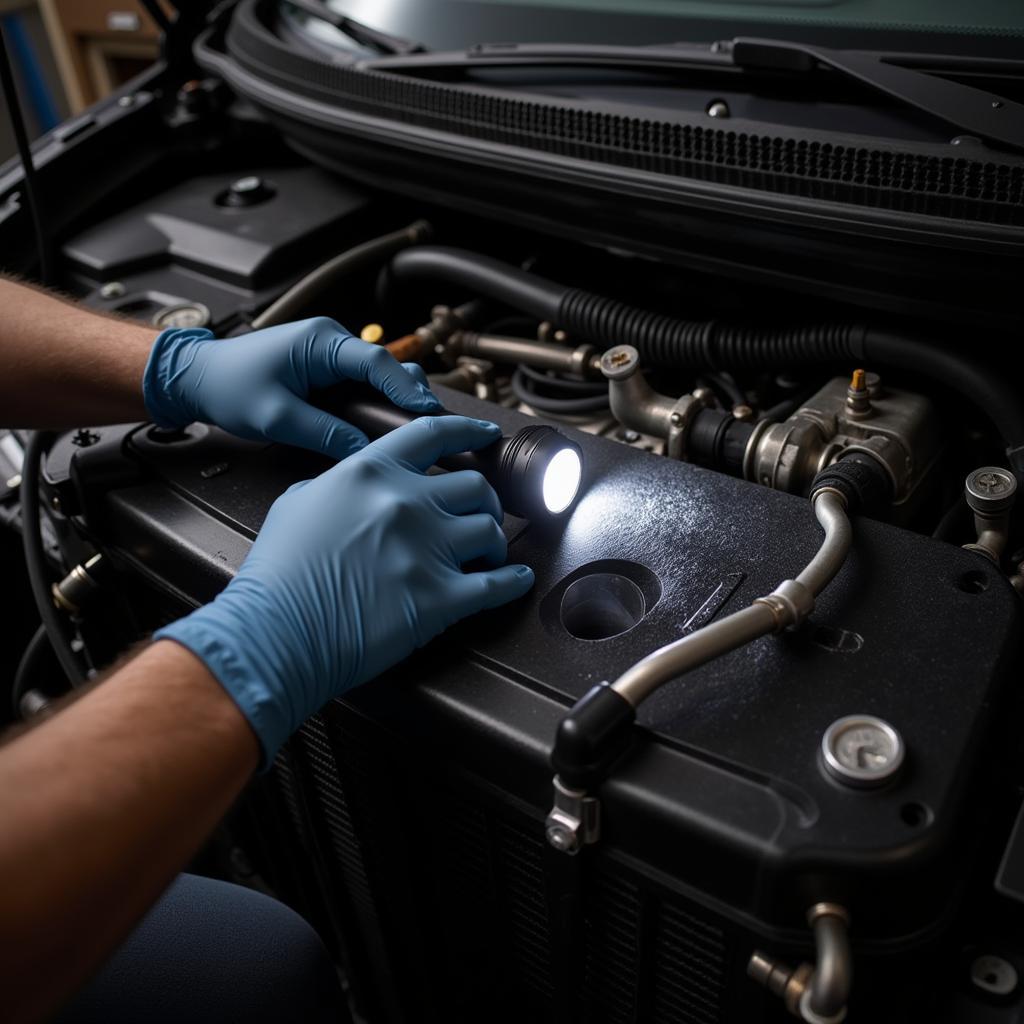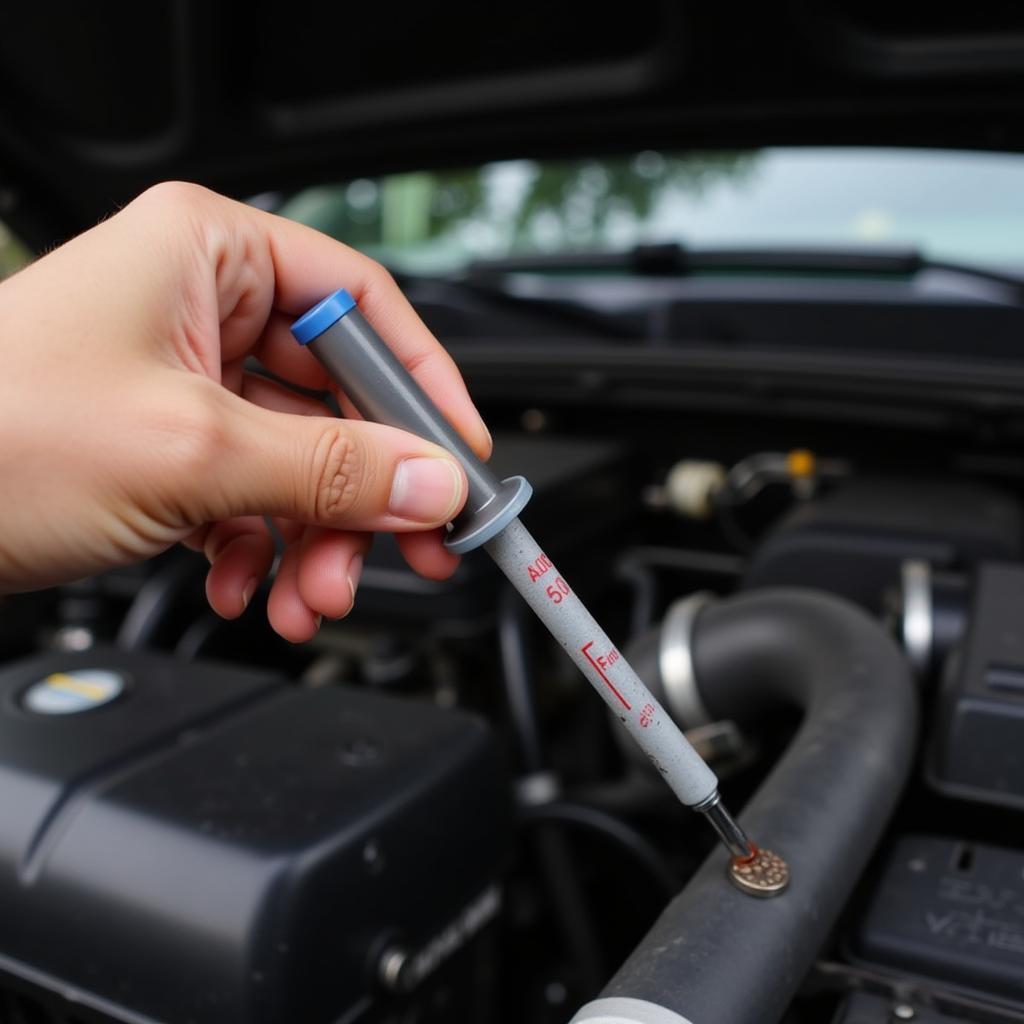A leaking radiator is a serious issue that can lead to engine overheating and costly repairs. If you notice coolant pooling under your car or your engine temperature gauge is creeping up, you may have a radiator leak. While some leaks require professional attention, many can be addressed with basic mechanical skills and a bit of patience. This comprehensive guide will walk you through the steps of diagnosing and fixing a leaking radiator in your car.
Identifying the Leak
Before you can fix a radiator leak, you need to pinpoint its location. Here’s how:
- Let the Engine Cool: Park your car on a level surface and allow the engine to cool down completely. A hot radiator is dangerous and pressurized, risking burns if tampered with.
- Locate the Radiator: Open the hood and identify the radiator. It’s typically located at the front of the engine bay and resembles a honeycomb structure made of metal.
- Inspect for Leaks: Carefully examine the radiator for any signs of leaks. Look for:
- Coolant Puddles: Check the ground beneath the radiator for any signs of coolant.
- Wet Spots: Inspect the radiator itself for dampness or wet spots, indicating active leaks or areas where coolant has dried.
- White Residue: Dried coolant often leaves a white, powdery residue. Look for this around hose connections and potential leak points.
 Detecting a car radiator leak
Detecting a car radiator leak
Common Radiator Leak Causes
Understanding the common causes of radiator leaks can help you determine the severity of the issue and choose the appropriate repair method.
- Cracked Radiator: Over time, the radiator can develop cracks due to age, corrosion, or vibration. These cracks can range from small hairline fractures to large splits.
- Damaged Radiator Cap: The radiator cap maintains pressure in the cooling system. A faulty cap can cause pressure to build and lead to leaks.
- Faulty Hoses: The radiator is connected to the engine with hoses. These hoses can deteriorate, crack, or become loose, resulting in coolant leaks.
- Loose or Damaged Clamps: Clamps secure the hoses to the radiator and engine. If a clamp is loose or damaged, it can cause a leak.
How to Fix a Leaking Radiator
The repair method you choose will depend on the severity and location of the leak. Here are some common solutions:
1. Tightening Clamps
If the leak is coming from a hose connection, the solution may be as simple as tightening the clamp.
- Use a screwdriver or socket wrench to tighten the clamp.
- Avoid over-tightening, as this can damage the hose or the radiator neck.
- Start the engine and check for leaks.
2. Replacing Hoses
Cracked or damaged hoses require replacement.
- Locate the leaking hose: Identify the hose that needs replacement.
- Drain the coolant: Place a drain pan under the radiator and open the drain valve to drain the coolant.
- Remove the hose: Loosen the clamps and carefully remove the old hose.
- Install the new hose: Install the new hose with new clamps, ensuring a tight fit.
- Refill coolant: Close the drain valve and refill the radiator with the recommended coolant type.
3. Using Radiator Stop Leak
For small leaks, radiator stop leak products can provide a temporary fix.
- Purchase a reputable radiator stop leak product.
- Pour the product into the radiator: Follow the instructions on the product label.
- Run the engine: Allow the engine to run for the recommended amount of time to circulate the product.
- Monitor for leaks: Check for leaks after using the stop leak.
Expert Insight:
“Radiator stop leak products should only be used as a temporary fix. They can clog other parts of the cooling system over time,” says John Smith, a certified mechanic with 20 years of experience.
4. Replacing the Radiator Cap
A faulty radiator cap can’t maintain the correct pressure, leading to leaks. Replacing it is a simple process:
- Allow the engine to cool.
- Place a rag over the cap and slowly turn it to release pressure.
- Remove the old cap and install the new cap.
- Ensure the cap is properly secured.
5. Radiator Replacement
For major cracks or damage, radiator replacement is often the most viable option. This repair is best left to professionals, especially if you’re not comfortable working with the car’s cooling system.
how to fix a car with a blown head gasket
When to Seek Professional Help
While some radiator repairs can be DIY projects, certain situations warrant professional help:
- Major Radiator Damage: Extensive cracks or damage usually mean the radiator needs replacement.
- You Can’t Locate the Leak: If you can’t find the source of the leak, it’s best to consult a mechanic.
- You’re Not Comfortable: If you’re not confident in your mechanical skills, don’t hesitate to take your car to a professional.
Preventing Future Radiator Leaks
Here are some tips to help prevent future radiator leaks:
- Regular Inspections: Inspect your radiator and hoses regularly for signs of wear and tear.
- Flush Your Coolant: Flush and replace your coolant according to your car’s maintenance schedule.
- Use the Correct Coolant: Always use the type of coolant specified in your owner’s manual.
- Address Small Leaks Promptly: Don’t ignore small leaks. Addressing them early can prevent bigger problems down the road.
Conclusion
A leaking radiator can be a significant problem, but understanding the issue and taking prompt action can help you avoid costly repairs and engine damage. By following the steps outlined in this guide, you can effectively diagnose and potentially fix a leaking radiator in your car. However, it’s crucial to recognize when a problem exceeds your skillset and seek professional help. Remember, regular maintenance and prompt attention to leaks are key to keeping your car’s cooling system in optimal condition.
Need help with a leaking radiator or other car repairs? Contact AutoTipPro today at +1 (641) 206-8880 or visit our office at 500 N St Mary’s St, San Antonio, TX 78205, United States. Our team of expert technicians is here to assist you.






Leave a Reply